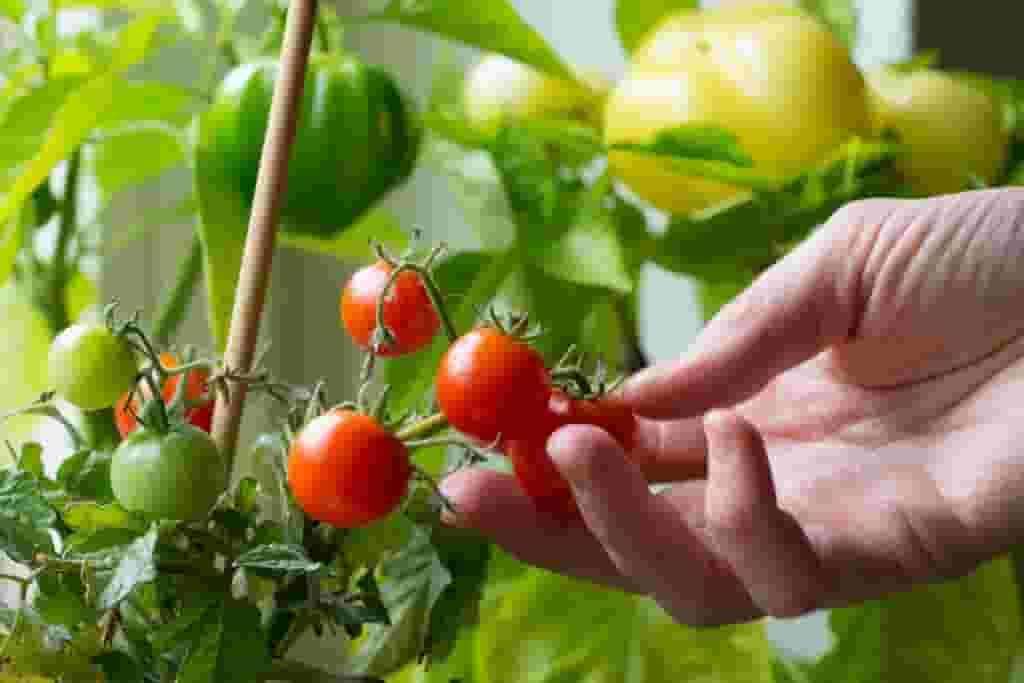Growing Tomatoes
Learn How to Grow and Care for Tomato Plants

Growing tomatoes is an easy and rewarding practice that can provide you with fresh, healthy tomatoes throughout the summer. Let’s go over some of the basics involved in the process and cover some important tips to help ensure a decent harvest.
Let’s start with what you’ll need:
- • Tomato plants or seeds
- • Soil enhancer such as composted manure (nutrient rich)
- • Digging tools such as a small shovel or trowel
- • Twine or string for tying
- • Tomato cages or stakes (for support)
Okay, now you’re ready to start!
Starting Tomato Plants from Seed
If starting your tomatoes by seed, it’s recommended that you begin indoors in the spring, approximately one month before you transplant them into their permanent location (directly into the soil or in a container). When starting tomatoes from seed, you can use planting flats, small containers, Styrofoam cups or another similar small container like a cut-in-half water or soda bottle. Seeds started indoors will require overhead light, such as a hanging florescent lamp. Tomato seeds generally take about 5 to 10 days to germinate. Raise the seedlings indoors under the light until the reach 7 to 10 inches tall – now they’re ready to be transplanted outdoors.
Prepare or purchase a seed starting mix with a combination of vermiculite, peat moss and perlite. Garden soil is not ideal for starting seeds, as it’s prone to compaction and often encourages disease causing organisms to flourish. If purchasing, look for brands like ProMix or Jiffy Mix, which are ideal in composition.
Buying Tomato Plants
If you’re planning on purchasing plants, there are several varieties to choose from. First time growers often have more success with varieties like Early Girl, Big Boy, Creole, Better Boy, Lemon Boy, Brandywine or any type of grape or cherry tomato. It’s recommended to plant two or three different varieties in order to have a continual harvest from mid to late summer.
When buying tomato plants, bigger is not always better – unless you’re buying them late in the season. Look for healthy plants with no signs of damage or disease. Again, try to choose a couple of varieties instead of planting many of the same variety. Plants can cost anywhere from $5 to $8 CAD dollars, well above the cost of starting from seed.
Harden off Tomato Transplants
It’s important to harden off your transplants prior to planting in their final location in the sun. This practice allows the plants to acclimatize to the outdoors and the sun. By not hardening off the tomato plants, you run the risk of putting the transplants into shock, which can either halt the growing process or kill the plants completely. Over several days, allow the transplants to have a little more sun than the day before – avoiding direct, or prolonged exposure to sunlight and cold temperatures. Taking transplants in at night is also recommended, as the chance of frost in the spring is possible and can kill the transplants.
Planting Tomatoes
Now that your transplants are ready for their final home, you’ll want to prepare the soil for planting. Breaking up the soil is necessary if it’s compacted or currently supporting grass or weeds. While it’s not necessary to completely till the ground, it is important that there is enough loose soil for the roots to take hold and start feeding. Using a trowel or a small shovel is probably the best way to work the soil for individual plantings, or you can simply till the land in a larger area. Soil that is loose can be more prone to weeds, as the seeds can penetrate the soil and take root
When planting, be sure that the hole is big enough to accommodate the entire root system, which allows for continued, uninterrupted root growth. Cover with soil until the root system is no longer visible (generally the top of the soil containing the transplant)
Once you have all your tomato plants in the ground, or container, you’ll want to set up either some tomato cages or stakes that will support the growing plants / fruit – yes, tomatoes are a member of the fruit family. Be sure that they are positioned in order to support the stock and branches – you may need to reposition cages or stakes as the plants grow and require additional support in some areas.
Watering Tomato Plants
Water! Now that the hard work of planting is done, it’s time to water. You can mix some root starter / stimulator into a watering can and apply right after planting – this will help the roots to spread and grow into the new soil. It’s not recommended to water tomato plants from above, as this can cause the plants to be more susceptible to disease and infection – watering below the leaf level is recommended. New plants need to be watched closely for the first few days to ensure that they are not drying out or suffering from shock. Never let the soil get too dry or too wet (in the case of self-watering). Rain really is the best form of moisture for the plants – and it’s free!
Picking Tomatoes

After all this time of meticulous care and watering, you’ve started to see the fruits of your labour – tomatoes! While different tomato varieties will appear to grow at different rates and sizes, it’s important to pick your tomatoes before they get too ripe – ripe tomatoes are a favorite delicacy for many pests, including insects, rodents and racoons. If you’re happy with the size of some unripe tomatoes (they will be green) you can pick them and allow them to ripen indoors on a window sill or somewhere where they get exposure to light.
Last Step – Eat and enjoy your home grown, nutrient rich, delicious tomatoes.